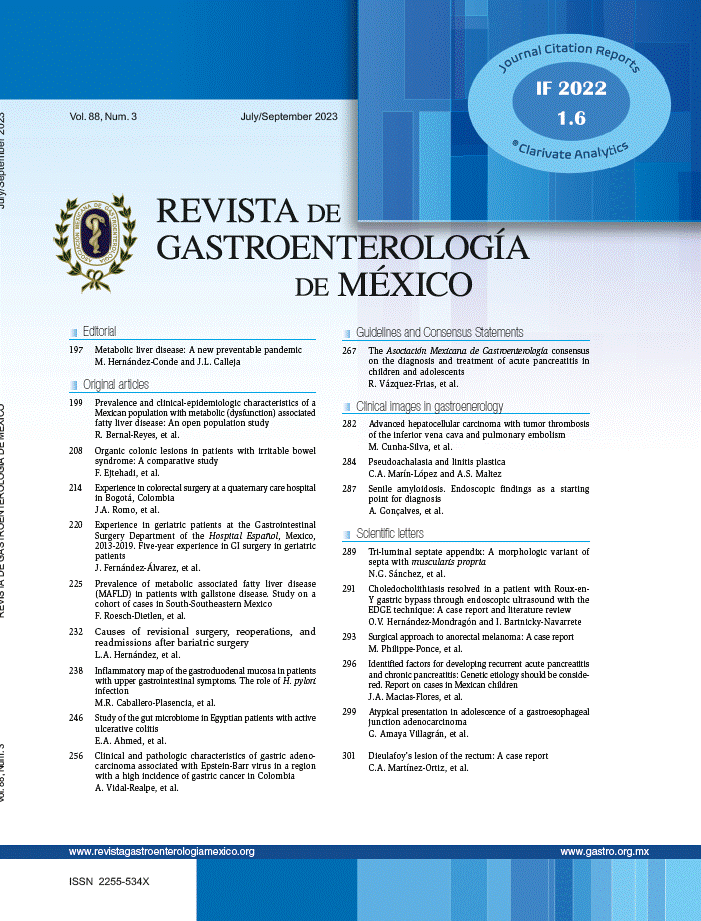We have read the article “Is celiac disease better identified through HLA-DQ8 than through HLA-DQ2 in Mexican subjects?” by Cerda-Contreras et al.1 with interest, presented as the first exploratory study on the theme conducted in Mexico. The authors evaluated the frequency of those haplotypes in a group of 30 patients with celiac disease (CD) and 19 patients with other diagnoses associated with chronic diarrhea. We consider it pertinent to make a few comments.
The results coincide with those we published in 2015, also in the Revista de Gastroenterología de México,2 in which, in addition to analyzing the distribution of those genetic variants in CD, we compared them with the allelic prevalence in the general population of Northwestern Mexico, calculating a genetic risk gradient associated with HLA for CD in the Mexican population. There is an elevated prevalence of DQ8 in Mexicans with CD.
Cerda-Contreras et al. suggest that the HLA-DQ8 haplotype may identify patients with CD better than the HLA-DQ2 haplotype, due to the fact that in their sample, DQ8 was more frequent in the patients with CD than in those without the disease, whereas the difference was less for DQ2. We observed2 that the joint presence of the two haplotypes or the combination of DQ8 with the DQB1*0201 allele of DQ2, conferred the maximum risk for CD in our population and that did not occur with isolated DQ8. In addition, considering that the prevalence of both haplotypes2 was similar in the general population studied, it would be expected for the two haplotypes to contribute to genetic risk, and not mainly DQ2, as occurs in Europeans, or mainly DQ8, as would occur in populations with a greater prevalence of Amerindian genes.
Furthermore, the typing of haplotypes should not be utilized as a strategy for making the differential diagnosis, given that although it has high sensitivity, its specificity is low.3 In adult patients, such as those in the study by Cerda-Contreras et al., its usefulness should be in facilitating the ruling out of CD in patients with borderline autoantibody figures, but not recommended as a marker for identifying CD cases, given that the presence of the haplotypes does not confirm CD diagnosis, but their absence does exclude it.3 In their results,1 in the patients with chronic diarrhea and no CD, the authors detected frequencies for both haplotypes far above those expected for the general Mexican population (63% for DQ2 and 37% for DQ8), providing evidence as to their low specificity as a diagnostic tool. The corresponding position of the ESPHGAN supports their use as a diagnostic tool only in children with gastrointestinal symptoms and repeatedly positive autoantibodies, so that intestinal biopsy can be omitted as part of the diagnostic protocol.4
Finally, after our abovementioned study, another was published in which we described a very practical and economic method for analyzing HLA-DQ2/DQ85 in cases such as those in the study by Cerda-Contreras et al., for the purpose of making CD diagnosis or conducting epidemiologic studies.
Ethical disclosuresProtection of human and animal subjectsThe authors declare that no experiments were performed on humans or animals for this study.
Confidentiality of dataThe authors declare that they have followed the protocols of their work center on the publication of patient data.
Right to privacy and informed consentThe authors declare that no patient data appear in this article.
Financial disclosureNo financial support was received in relation to this article.
Conflict of interestThe authors declare that there is no conflict of interest.
Please cite this article as: Mejía-León ME, Calderón-de la Barca AM. Prevalencia de haplotipos HLA-DQ2 y DQ8 que predisponen a enfermedad celiaca en México. Revista de Gastroenterología de México. 2019;84:123–124.



